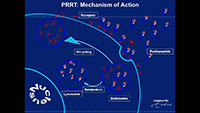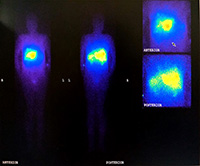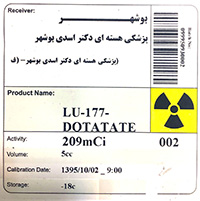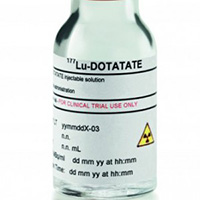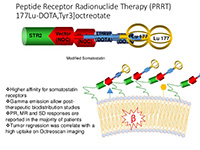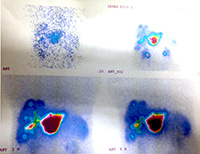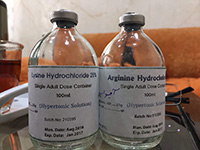Peptide Receptor Radionuclide Therapy (PRRT) in neuroendocrine tumors
Newsid: 1068 Date: Jan 20, 2017
What is peptide receptor radionuclide therapy (PRRT) and how does it work?
Peptide receptor radionuclide therapy (PRRT) is a molecular therapy (also called radioisotope therapy) used to treat a specific type of cancer called neuroendocrine carcinoma or NETs (neuroendocrine tumors). PRRT is also currently being investigated as a treatment for prostate and pancreatic tumors.
In PRRT, a cell-targeting protein (or peptide) called octreotide is combined with a small amount of radioactive material, or radionuclide, creating a special type of radiopharmaceutical called a radiopeptide. When injected into the patient’s bloodstream, this radiopeptide travels to and binds to neuroendocrine tumor cells, delivering a high dose of radiation to the cancer.
The cells in most neuroendocrine tumors have an abundance (called an overexpression) of a specific type of surface receptor—a protein that extends from the cell’s surface—that binds to a hormone in the body called somatostatin. Octreotide is a laboratory-made version of this hormone that binds to somatostatin receptors on neuroendocrine tumors. In PRRT, octreotide is combined with a therapeutic dose of the radionuclides. Yttrium 90 (Y-90) and Lutetium 177 (Lu-177) are the most commonly used radionuclides.
What conditions are treated with PRRT?
PRRT may be used to treat NETs, including carcinoids,islet cell carcinoma of the pancreas, small cell carcinoma of the lung, pheochromocytoma (a rare tumor that forms in the adrenal glands), gastro-enteropancreatic (stomach, intestines and pancreas) neuroendocrine tumors, and rare thyroid cancers that are unresponsive to treatment with radioiodine.
PRRT is an option for patients:
• who have advanced and/or progressive neuroendocrine tumors
• who are not candidates for surgery
• whose symptoms do not respond to other medical therapies.
The main goals of PRRT are to provide symptom relief, to stop or slow tumor progression and to improve overall survival.
How is PRRT performed?
Depending on the type of cancer being treated and the medical facility performing the procedure, patients may undergo up to 10 PRRT sessions spaced two to three months apart. Depending on the radionuclide being used and local regulations, the procedure may be done as an outpatient procedure or may require a hospital stay of a few days.
Each PRRT session begins with an amino acid solution delivered intravenously to protect the patient’s kidneys from the effects of the radiation. The radiopeptide is then injected into the patient, followed by additional amino acid solution. In total, the treatment session lasts approximately four hours.
Molecular imaging scans may be taken during and following the treatment process to see where the injected radiopeptide has traveled in the body, although this is not mandatory.
What are the advantages of PRRT?
PRRT and other molecular therapies offer more personalized cancer treatment because radiopharmaceuticals can be tailored to the unique biologic characteristics of the patient and the molecular properties of the tumor. PRRT is also considered a targeted therapy because radiopeptides are highly selective in their ability to damage neuroendocrine tumor cells, while limiting radiation exposure to healthy tissue. As a result, PRRT typically has milder side effects compared with chemotherapy.
PRRT is a treatment option that is highly effective in controlling advanced, progressive neuroendocrine tumors. PRRT is not curative, but has been shown to help relieve symptoms and slow the progression of the disease.
Is PRRT safe?
All therapies, including PRRT, have side effects and risks. You should discuss with your medical provider the risks and benefits of PRRT and any other therapies you are considering. Your medical provider will help you determine whether PRRT is right for you, given your medical history. Please make sure to tell your provider about any prior therapies you have received, as this can play a role in determining the correct therapy and dosage.
Side effects
The administration of the PRRT itself is quite well tolerated, but patients often experience nausea and vomiting (which can be severe) during the amino acid infusion. This is managed with anti-nausea medication or slowing down the administration of the amino acids. More long term, the side effects can include a suppression of blood cell counts. Overall, however, the treatment is well tolerated by most patients.
Home care
Your medical facility will provide you with instructions for special care to be taken following treatment. Because small amounts of radiation can remain in the body, patients need to be isolated from others for one to two days following PRRT therapy. As the remaining radionuclide is eliminated from the body through the urine and feces, it is important to maintain good bathroom hygiene during this period.
Reference: http://www.snmmi.org/AboutSNMMI/Content.aspx?ItemNumber=5691

